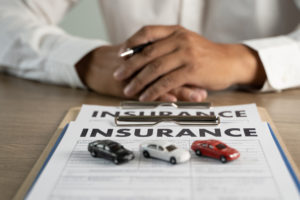A West Palm Beach Accident Lawyer Discusses “Stacking” Auto Insurance Coverage

Generally speaking, “stacking” insurance is a way to raise your insurance coverage if you are in an accident with an uninsured or underinsured driver. Stacked car insurance adds the uninsured/underinsured motorist coverage limits for multiple vehicles/policies in order to increase the maximum amount an insurance policy will pay.
The first piece of important information is that in terms of auto insurance:
- Only uninsured motorist (UM) or underinsured motorist (UIM) bodily injury coverage can be stacked.
- UM and UIM property liability insurance cannot be stacked.
A total of 32 states, including Florida, allow stacking insurance in some form.
Stacking your insurance can be a valuable tool for increasing your coverage. If you or a loved one has been injured or even killed in a multi-vehicle accident in the West Palm Beach area, immediately contact an experienced West Palm Beach accident lawyer at Searcy Denney for your free consultation. We’ll examine your stacked insurance options and find the best way to increase your coverage.
Stacked Insurance
When insurance policies are stacked, their coverage limits are added together. There are two ways to stack coverages:
Stacked Across Multiple Policies
When you have multiple insurance policies, you may be able to stack the uninsured motorist coverage limits. This could come into play if you have your own insurance policy and your name is also on another policy, say that of a spouse or family member. This is sometimes called vertical stacking.
For instance, say your own vehicle’s insurance includes a $50,000 uninsured motorist bodily injury coverage limit. Your name is also on the insurance policy for your wife’s car, and that policy also has $50,000 in uninsured motorist injury coverage. For slightly higher premiums, you can stack these insurance policies for $100,000 in coverage if you are in an accident with an uninsured driver.
Stacking Within One Auto Insurance Policy
If you have one policy that insures multiple vehicles, you can pay a little more and opt to stack the uninsured or underinsured coverage. Since each vehicle has its own coverage limit, those limits can be stacked. This is sometimes called horizontal stacking.
For instance, say you own two cars, both insured on the same auto policy. You’ve insured both with $25,000 of underinsured motorist coverage. If you pay to stack the policies, you’ll have $50,000 in potential coverage.
Advantages of Stacked Insurance
Stacked insurance allows you to safeguard your finances if you are in an accident caused by an uninsured or underinsured driver. Some accidents can be expensive, and the higher your coverage limits are, the more money your insurance company will pay, reducing your out-of-pocket expenses for an uninsured motorist claim.
Stacked insurance is worth getting if you are financially comfortable paying a small bit more for your coverage. There are savings that come with unstacked insurance, but the cost to stack insurance is usually lower than $10 a month. In some cases, there is no cost difference at all, in which case, there is no downside to stacking. If you are on multiple policies or have multiple vehicles on the same policy, it’s an inexpensive way to increase coverage.
Other considerations to keep in mind when choosing between stacked vs. unstacked insurance:
- Some states and/or policies do not permit stacking for motorcycles, boats, or other non-traditional vehicles other than traditional four-wheeled cars.
- UM/UIM insurance may only apply if the UN/UIM driver causes the accident; some states do not allow collection if you are at fault.
- Some states might not allow stacking for accidents in which you were acting as the driver. At the same time, stacking UM/UIM to cover yourself or your family members when you are involved as passengers or pedestrians may be permitted.
Be aware that more than ten percent of U.S. drivers are uninsured, and that rate is significantly higher in certain regions. For example, in Florida, 27% of drivers don’t have insurance.
If stacking is not allowed in your state, or you are otherwise unable to stack policies, an alternative is to increase your uninsured and underinsured motorist coverage limits. This will also cost more, but it offers more security if you find yourself in an accident with a driver who cannot cover the damage.
How to Get Stacked Insurance
If you decide on stacked insurance, you must have uninsured/underinsured motorist coverage on multiple vehicles, provided by one policy or multiple policies. In addition, you must live in one of the 32 states, including Florida, that allow insurance stacking.
Your ability to stack insurance is also dependent on your car insurance company. Some states allow insurers to deny customers the ability to stack coverage as long as they are clear and unambiguous in the policy.
Contact a West Palm Beach Accident Lawyer for More Information on Stacking Insurance
Stacking insurance allows you to increase your coverage if you’ve been involved in an accident with an uninsured or underinsured driver. Call 800-780-8607 or contact a West Palm Beach accident lawyer at Searcy Denney to schedule your free consultation. We’ll make sure you can collect the maximum financial compensation that you’re entitled to. We work on a contingency fee basis.
Share This


